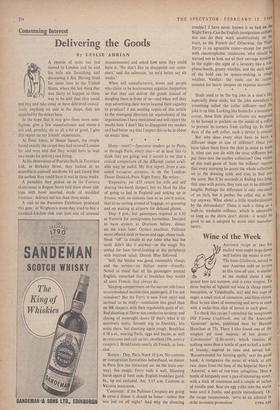Consuming Interest
Delivering the Goods
By LESLI E ADRIAN In the hope that it may give them some satis- faction, give a few manufacturers and stores a jolt and, possibly, do us all a bit of good, I give this report on my friends' experiences.
At Peter Jones, in Sloane Square, the couple found exactly the carpet they had scoured London for and were told that they would have to wait two weeks for delivery and fitting.
At the showrooms of Peerless Built-In Furniture Ltd., in Berkeley Street, they looked at an assemble-it-yourself wardrobe kit and found that the earliest they could have it was in three weeks.
A pamphlet they picked up in the Formica showrooms in Regent Street told them about sink tops with bowl inserted, made of moulded Formica : delivery not less than three weeks.
A visit to the Furniture Exhibition produced this gem : at Wrighton's stand they tried to buy a standard kitchen sink unit (not one of unusual measurements) and asked how soon they could have it. 'We don't like to disappoint our custo- mers,' said the salesman, `so we'd better say six weeks.'
When will manufacturers, stores and people who claim to be businessmen organise themselves so that they can deliver the goods instead of dangling them in front of us—and when will they stop advertising their wares beyond their capacity to produce? I am sending copies of this article to the managing directors (or equivalents) of the organisations I have mentioned and will report the results here. I don't like to disappoint my readers so I had better say that I expect this to be in about six weeks time.
Many—most?—Spectator readers go to Paris, or through Paris, every year—or at least like to think they are going; and it occurs to me that a critical comparison of. the different routes avail- able may be useful. My first report, from a sea- soned voyageur porn pier, is on the London- Dover-Dunkirk-Paris Night Ferry. He writes : 'Expensive, yes (£35 return for wife and self sharing two-berth sleeper); but we liked the idea of going to bed in England and waking up in France, with no customs (not so as you'd notice, that is) no carting around of baggage, no queueing and no waiting at airports for delayed planes.
Dep. 9 p.m., but passengers required at 8.30 at Victoria for immigration formalities. Decided to have oysters at Overtons before, dinner on the train later. Oysters excellent. Pullman menu offered steak or bacon and eggs; chose steak. Steak "off" (a couple at our table who had the steak didn't like it anyway—or the soup). We settled for ham (tired-looking at the periphery) with beetroot salad; Danish Blue followed.
'Still, the M6doc was good, reasonably cheap; and the service—an Italian waiter—friendly. Noted as usual that all the passengers seemed English; remarked that at breakfast they would all seem French; they always do.
'Sleeping compartment on the narrow side (once accommodated second-class passengers, if I'm not mistaken? But the Ferry is now First only) and inclined to be stuffy—ventilation less good than on BR sleepers, with their regulatable gusts of air. Bad shunting at Dover not conducive to sleep; and closing of watertight doors (if that's what it is) extremely noisy. Smooth trip to Dunkirk; less noisy there, but shunting again rough. Breakfast 8.30 a.m., nearing Paris; eggs and bacon, as well as croissants and café an lait, excellent (10s. service compris.). Breakfasters nearly all French, as fore- cast.
'Return : Dep. Paris Nord 10 p.m. No customs or immigration formalities beforehand, so dinner in Paris first (no restaurant car on the train any- way). Sea rough; Ferry rode it well, Shunting harsh again at both ends. English breakfast good, 8s., tip not included. Arr. 9.15 a.m. Customs at Victoria innocuous.
'Comment: if the Pullman Company are going to serve a dinner it should be better—unless this was just an off night? And why the shunting trouble? I have never known it so bad on the Night Ferry. Can the English immigration authorl' ties not do their work unobtrusively on the train, as the French do? Otherwise, the Night Ferry is an agreeable route—except for peollic with claustrophobic tendencies, who should be warned not to look out of their carriage windows in the night—the sight of a lavatory like a tele" phone-booth, greasy winches, and the dark sidel of the hold can be quease-making in rough weather. Verdict: the route can be reconl: mended for heavy sleepers on expense accounts, Studs used to be the big joke in a man's life, especially dress studs, but the joke nowadays ig something called the collar stiffener—and the joke is on him. Looking like bones for a miniature corset, these little plastic irritants are supposed to be housed in pockets on the inside of a collar to prevent its corners from curling up. In these days of the soft collar, such a device is crucial.
But why does every shirt have to have 3 different shape or size of stiffener? Once You have taken them from the shirt in order to wash it, what can you do with the stray stiffeners but put them into the motley collection? One victim of this mad game of 'hunt the stiffener' reports that every morning he pours the whole collection on to the dressing table and tries to find two the same. But if he succeeds in finding two long, thin ones with points, they turn out to be different lengths. Perhaps the difference is only one-tenth of an inch, but it pushes the collar out at the top anyway. What about a little standardisation by the shirtmakers? There is such a thing as a built-in, washable stiffener, which is admirable so long as the shirts don't shrink—it would be good to see it adopted by more shirt manufac- turers.






































 Previous page
Previous page